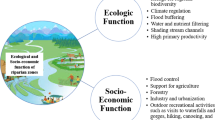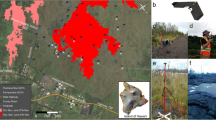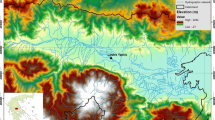Abstract
Upstream agriculture and infrastructure development can greatly alter downstream hydrology, cutting off water sources and modifying connectivity that is critical for wetland survival. For tracts within the Anahuac National Wildlife Refuge (ANWR) located on the Texas Gulf Coast, our overall objective was to identify how much freshwater was needed to offset these processes. We sought to examine the historical trajectory of wetlands change, identify how to optimally route water through former agricultural canals, and make initial gross estimates of the volumetric water requirements. To prioritize specific restoration actions given the extremely flat topography of this sheet flow landscape, we used a combination of field survey by Unmanned Aerial Vehicles (UAVs), direct observation via airboats, Global Navigation Satellite System (GNSS) technologies, and remote assessment using aerial photography, LIDAR datasets, and Geographic Information Systems (GIS). We found that the optimal solution would minimize construction work and the quantity of water needed for purchase, while maximizing the inundation across the landscape. The unique combination of spatial technologies applied in this study provides a template for future work in similar sheet flow-fed landscapes affected by hydrologic disconnection and relative sea level rise.





Similar content being viewed by others
References
Archarya S, Kaplan DA, Jawitz JW, Cohen MJ (2017) Doing ecohydrology backward: inferring wetland flow and hydroperiod from landscape patterns. Water Resources Research 53:5742–5755
Barbier EB, Hacker SD, Kennedy C, Koch EW, Stier AC, Silliman BR (2011) The value of estuarine and coastal ecosystem services. Ecological Monographs 81:169–193
Baustian JJ, Turner RE (2006) Restoration success of backfilling canals in coastal Louisiana marshes. Restoration Ecology 14:636–644
Baustian JJ, Piazza BP, Bergan JF (2019) Hydrologic connectivity and backswamp water quality during a flood in the Atchafalaya Basin, USA. River Research and Applications 35:430–435
Berkowitz JF, Page S, Noble CV (2014) Potential disconnect between observations of hydrophytic vegetation, wetland hydrology indicators, and hydric soils in unique pitcher plant bog habitats of the southern Gulf Coast. Southeastern Naturalist 13:721–734
Birkigt J, Stumpp C, Małoszewski P, Nijenhuis I (2018) Evaluation of the hydrological flow paths in a gravel bed filter modeling a horizontal subsurface flow wetland by using a multi-tracer experiment. Science of the Total Environment 621:265–272
Brinson MM (1993) A Hydrogeomorphic classification for wetlands. Technical report WRP-DE-4, US Army Corps of Engineers Waterways Experiment Station, Vicksburg, MS
Cai Y, Huang G, Tan Q, Chen B (2011) Identification of optimal strategies for improving eco-resilience to floods in ecologically vulnerable regions of a wetland. Ecological Modelling 222:360–369
Chan AW, Zoback MD (2007) The role of hydrocarbon production on land subsidence and fault reactivation in the Louisiana coastal zone. Journal of Coastal Research 23:771–786
Colón-Rivera RJ, Feagin RA, West JB, Yeager KM (2012) Salt marsh connectivity and freshwater versus saltwater inflow: multiple methods including tidal gauges, water isotopes, and LIDAR elevation models. Canadian Journal of Fisheries and Aquatic Sciences 69:1420–1432
Cordell S, Questad EJ, Asner GP, Kinney KM, Thaxton JM, Uowolo A, Brooks S, Chynoweth MW (2017) Remote sensing for restoration planning: how the big picture can inform stakeholders. Restoration Ecology 25:S147–S154
Day JW, Point E, Hensfi PF, Ibanez C (1995) Impacts of sea-level rise on deltas in the Gulf of Mexico and the Mediterranean: the importance of pulsing events to sustainability. Estuaries 18:636–647
Delgado P, Hansel PF, Swarth CW, Ceroni M, Boumans R (2013) Sustainability of a tidal freshwater marsh exposed to long-term hydrologic barrier and sea level rise. Estuaries and Coasts 36:585–594
Feagin R (2018) Canal network assessment and subsidence assessment for the purpose of restoring freshwater inflows in Jackson Ditch and East Bay Bayou. Report no. 1801-098, National Wildlife Federation, Reston, VA
Feagin R, Yeager K, Brunner C, Paine J (2013) Active fault motion in a coastal wetland: Matagorda, Texas. Geomorphology 199:150–159
Fernández IC, Morales NS (2016) A spatial multicriteria decision analysis for selecting priority sites for plant species restoration: a case study from the Chilean biodiversity hotspot. Restoration Ecology 24:599–608
Franzén F, Dinnétz P, Hammer M (2016) Factors affecting farmers' willingness to participate in eutrophication mitigation—a case study of preferences for wetland creation in Sweden. Ecological Economics 130:8–15
Gustavson TC, Kreitler CW (1976) Geothermal resources of the Texas Gulf Coast-Environmental concerns arising from the production and disposal of geothermal waters. University of Texas at Austin, Bureau of Economic Geology, Geological Circular 76–7, 35 pg
Gusyev MA, Haitjema HM (2011) Modeling flow in wetlands and underlying aquifers using a discharge potential formulation. Journal of Hydrology 204:91–99
Hacısalihoğlu S, Karaer F, Katip A (2016) Applications of geographic information system (GIS) analysis of Lake Uluabat. Environmental Monitoring and Assessment 188:331
Halbouty MT (1936) Geology and geophysics showing cap rock and salt overhang of High Island dome, Galveston County, Texas. AAPG Bulletin 20:560–611
Harvey JW, Schaffranek RW, Noe GB, Larsen LG, Nowacki DJ, O’Connor BL (2009) Hydroecological factors governing surface water flow on a low-gradient floodplain. Water Resources Research 45:W03421
Howard RJ, Day RH, Krauss KW, From AS, Allain L, Cormier N (2017) Hydrologic restoration in a dynamic subtropical mangrove-to-marsh ecotone. Restoration Ecology 25:471–482
Huff T, Feagin RA (2017a) Hydrological barrier as a cause of salt marsh loss. Journal of Coastal Research SI 77:88–96
Huff T, Feagin R (2017b) Restoring tidal equilibrium: removing a hydrological barrier and lowering salinity at the Magnolia inlet, Texas. Journal of Coastal Research SI 77:97–103
Insom P, Cao C, Boonsrimuang P, Torteeka P, Boonprong S, Liu D, Chen W (2017) The dynamics of wetland cover change using a state estimation technique applied to time-series remote sensing imagery. Geomatics, Natural Hazards and Risk 8:1662–1677
Jaramillo F, Brown I, Castellazi P, Espinoza L, Guittard A, Hong S-H, Rivera-Monroy VH, Wdowinski S (2019) Assessment of hydrologic connectivity in an ungauged wetland with InSAR observations. Environmental Research Letters 12:024003
Johnson JS, Cairns DM, Houser C (2013) Coastal marsh vegetation assemblages of Galveston Bay: insights for the East Texas Chenier plain. Wetlands 33:861–870
Jones JW (2015) Efficient wetland surface water detection and monitoring via Landsat: comparison with in situ data from the Everglades depth estimation network. Remote Sensing 7:12503–12538
Jones KL, Poole GC, O'Daniel SJ, Mertes LA, Stanford JA (2008) Surface hydrology of low-relief landscapes: assessing surface water flow impedance using LIDAR-derived digital elevation models. Remote Sensing of Environment 112:4148–4158
Jones CN, Evenson GR, McLaughlin DL, Vanderhoof MK, Lang MW, McCarty GW, Golden HE, Lane CR, Alexander LC (2017) Estimating restorable wetland water storage at landscape scales. Hydrological Processes 32:305–313
Kadlec RH (1990) Overland flow in wetlands: vegetative resistance. Journal of Hydraulic Engineering 116:691–706
Kreitler CW (1976) Lineations and faults in the Texas Coastal Zone. University of Texas at Austin, Bureau of Economic Geology, Report of Investigations No. 85, 32 pg
Larsen LG, Ma J, Kaplan D (2017) How important is connectivity for surface water fluxes? A generalized expression for flow through heterogenous landscapes. Geophysical Research Letters 44:10349–10358
Mallman EP, Zoback MD, Hagin P (2007) Subsidence in the Louisiana coastal zone due to hydrocarbon production. Journal of Coastal Research SI50:443–449
Małoszewski P, Wachniew P, Czupryński P (2006) Study of hydraulic parameters in heterogeneous gravel beds: constructed wetland in Nowa Słupia (Poland). Journal of Hydrology 331:630–642
Messer TL (2015) Predicting impacts of rerouting drainage water from the Pamlico sound to restored wetlands: a hydraulic and water quality assessment. North Carolina State University, Raleigh, NC, Dissertation
Mitsch WJ, Gosselink JG (2015) Wetlands, 5th edn. John Wiley & Sons, Hoboken, NJ
Morton RA, Bernier JC, Barras JA (2006) Evidence of regional subsidence and associated interior wetland loss induced by hydrocarbon production, Gulf Coast region, USA. Environmental Geology 50:261–274
Naja M, Childers DL, Gaiser EE (2017) Water quality implications of hydrologic restoration alternatives in the Florida Everglades, United States. Restoration Ecology 25:S48–S58
Osborne TZ, Fitz HC, Davis SE (2017) Restoring the foundation of the Everglades ecosystem: assessment of edaphic responses to hydrologic restoration scenarios. Restoration Ecology 25:S59–S70
Overton IC (2005) Modelling floodplain inundation on a regulated river: integrating GIS, remote sensing and hydrological models. River Research and Applications 21:991–1001
Owen CR (1995) Water budget and flow patterns in an urban wetland. Journal of Hydrology 169:171–187
Ozesmi SL, Bauer ME (2002) Satellite remote sensing of wetlands. Wetlands Ecology and Management 10:381–402
R Core Team (2018) R: A language and environment for statistical computing. R Foundation for Statistical Computing, Vienna, Austria.
Rebelo AJ, Le Maitre DC, Esler KJ, Cowling RM (2015) Hydrological responses of a valley-bottom wetland to land-use/land-cover change in a South African catchment: making a case for wetland restoration. Restoration Ecology 23:829–841
Silva TA, Freitas MC, Andrade C, Taborda R, Freire P, Schmidt S, Antunes C (2013) Geomorphological response of the salt-marshes in the Tagus estuary to sea level rise. Journal of Coastal Research 65:582–587
Stagg CL, Osland MJ, Moon JA, Hall CT, Feher LC, Jones WR, Couvillion BR, Hartley SB, Vervaeke WC (2020) Quantifying hydrologic controls on local- and landscape-scale indicators of coastal wetland loss. Annals of Botany 125:365–376
USFWS (2006) Texas Chenier plan refuge complex: draft environmental impact statement, comprehensive conservation plan, and land protection plan, vol 1. US Fish and Wildlife Service, Anahuac, TX
USGS (2004) Sheet-flow velocities and factors affecting sheet-flow behavior of importance to restoration of the Florida Everglades. US Geological Survey Fact Sheet:2004–3123
Uuemaa E, Hughes AO, Tanner CC (2018) Identifying feasible locations for wetland creation or restoration in catchments by suitability modelling using light detection and ranging (LiDAR) digital elevation model (DEM). Water 10:464
Verbeek ER (1979) Surface faults in the Gulf coastal plain between Victoria and Beaumont, Texas. Tectonophysics 52:373–375
Wdowinski S, Amelung F, Miralles-Wilhelm F, Dixon TH, Carande R (2004) Space-based measurements of sheet-flow characteristics in the Everglades wetland, Florida. Geophysical Research Letters 31:L15503
White E Jr, Kaplan D (2017) Restore or retreat? Saltwater intrusion and water management in coastal wetlands. Ecosystem Health and Sustainability 3:e01258
White WA, Morton RA (1997) Wetland losses related to fault movement and hydrocarbon production, southeastern Texas coast. Journal of Coastal Research 13:1305–1320
Yurek S, DeAngelis DL, Trexler JC, Klassen JA, Larsen LG (2016) Persistence and diversity of directional landscape connectivity pulsing in simulations of expanding and contracting wetlands. Ecological Complexity 28:1–11
Zedler JB, West JM (2007) Declining diversity in natural and restored salt marshes: a 30-year study of Tijuana estuary. Restoration Ecology 16:249–262
Acknowledgements
This work was part of the Texas Environmental Flows Initiative, with primary direction by the National Wildlife Federation, and funding from the Houston Endowment, the National Fish and Wildlife Foundation, the Harte Charitable Foundation, the Meadows Foundation, the Cynthia and George Mitchell Foundation, and Lyda Hill Holdings. We thank George Guillen for knowledge about measured salinities. We dedicate this work to memory of Patrick Walther, who had a deep knowledge of these lands.
Author information
Authors and Affiliations
Contributions
RAF, NJ, TPH, KF-G designed the research; RAF, TPH performed the work, analyzed data; RAF, NJ, MMA, TPH, KF-G wrote the manuscript.
Corresponding author
Additional information
Publisher’s Note
Springer Nature remains neutral with regard to jurisdictional claims in published maps and institutional affiliations.
Implications
- To restore sheet flow hydrology across flat and large areas, the use of a suite of spatial technologies such UAVs, GNSS, LIDAR, and GIS can be critical for planning and implementation efforts.
-The reintroduction of freshwater inflows to altered Chenier Plain landscapes can restore former freshwater drainages and ponds and also counter-act salt water intrusion caused by downstream modifications, though the success of either is highly site-specific.
-Hydrologic restoration of inflows is most optimal when construction and water purchase costs are minimized, while the inundation across the landscape is maximized
Appendix
Rights and permissions
About this article
Cite this article
Feagin, R.A., Johns, N., Huff, T.P. et al. Restoration of Freshwater Inflows: the Use of Spatial Analysis for Hydrologic Planning in the Anahuac National Wildlife Refuge, USA. Wetlands 40, 2561–2576 (2020). https://doi.org/10.1007/s13157-020-01318-0
Received:
Accepted:
Published:
Issue Date:
DOI: https://doi.org/10.1007/s13157-020-01318-0




